The English Village Explained: Britain’s Living History (5 page)
Read The English Village Explained: Britain’s Living History Online
Authors: Trevor Yorke

Monks were just as affected by the catastrophes of the 14th century as other landlords. There was a drop in revenue from their estates due to labour shortages, the change in the fashion of endowment was depriving them of valuable income, and their holy status was no protection against the ravages of the bubonic plague. To make matters worse, there was a general concern among the population about the running of the Church, which grew into
disrespect for some sections of the clergy and manifested itself in the simple act of jeering or even in riots! Some even questioned the monks’ rights to the very land upon which they were so dependent.
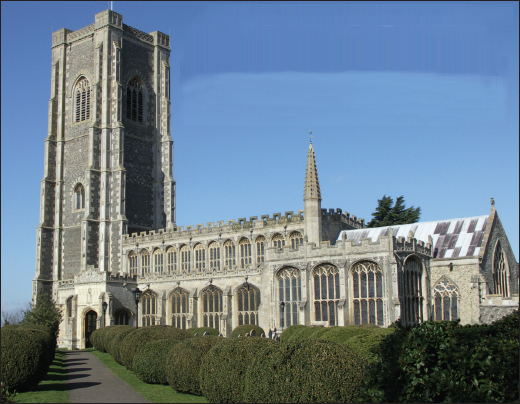
FIG 3.5 LAVENHAM CHURCH, SUFFOLK:
One of the great wool churches financed by local clothiers, with a tall tower and rows of large windows distinctive of similar buildings in Somerset and the Cotswolds from this period. Behind the three large windows below the small spire (centre) is a chantry chapel, a popular addition for wealthy families
.
The indifference to monastic life which evolved, mainly among the people of the south of England, made Henry VIII’s Dissolution of the Monasteries in the late 1530s that much easier, and his defeat of the opposition to it in the North ensured its swift completion. The Crown took all the rights and wealth of the abbeys and then granted the estates to courtiers and nobles or sold them off. At a village level this would mean a new landlord and a worrying future for those who had depended directly upon the monastery for employment or income. It also left a gap in the education system and in the support of the elderly and poor.
The most notable effect of the Black Death was the change in social structure due to the scarcity of labour. There simply were not the numbers of labourers required to work the land, so those who survived began to demand more money and rights, while lords of the manor might try and poach peasants from nearby villages. The tensions which grew between the labouring and ruling classes exploded in the Peasants’ Revolt in 1381, and despite the failure of this rising the continuing shortage in the workforce meant that the following century would see wages rise and peasants able to escape from the humiliation of servitude, which had been one of the rebels’ objectives.
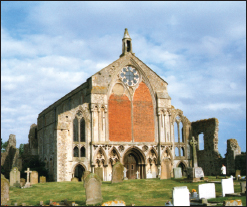
FIG 3.6 BINHAM PRIORY, NORFOLK:
This monastic establishment’s nave, in this view with its later bricked-up west window, was retained for villagers as a parish church while the rest of its buildings fell into disuse
.
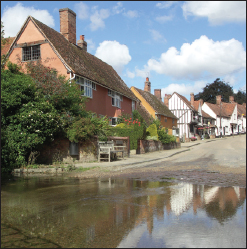
FIG 3.7 KERSEY, SUFFOLK:
A village which grew rich due to the local cloth trade in this period. A number of large two-storey, timber-framed buildings from the 15th and 16th centuries are testament to the money which could be made (the village gives its name to a distinctive type of cloth)
.
The acquisition of land by ambitious villagers was made possible by changes in tenancy agreements forced on the landlords by the difficulties in attaining workers, and by a decline in the practice of passing down property by inheritance to family members. Rather than working the lord’s land in return for a sustenance living, they could now escape this feudal system and farm their own holdings to try and make a profit. Villagers could also supplement their income by offering their services for seasonal or part-time employment, which could include brick and tile manufacturing, quarrying and mining, iron working, and breeding rabbits. If you owned a cart or plough you could lease them out, while other members of the household could bake bread or brew beer to sell to the slowly increasing numbers of long-distance travellers. Within their own plots they could also grow apple, plum, cherry and pear trees, plant vegetables, peas and beans, and even cut grass for fodder. In some cases these trades became full-time as inns were established and small-scale industries became permanent in certain locations.
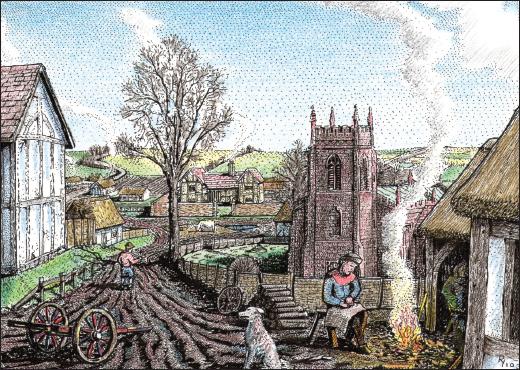
FIG 3.8:
A village scene from the end of this period with a large manor house in the background, an extended church in the centre and new houses for a select few to the left. A blacksmith’s workshop on the right is a recent addition as some trades become full-time rather than being seasonal or combined with farming duties
.
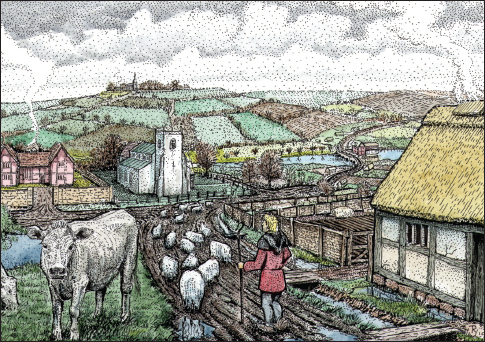
FIG 3.9 EXEMPLAR VILLAGE c1500:
Our imaginary village is showing signs of decline. The owner of the house being erected in the previous view has taken over the two plots next to him as they were deserted by their owners, and he has removed the buildings and turned the land over to crops. The market which was held on the green to the left was short-lived, and this grassy patch is only used by peasants to graze livestock. The manor house and church have been enlarged, mainly due to profits the lord has made from sheep farming, the previously open fields on the hill in the distance are now enclosed with hedges for his flocks
.
By the 16th century the regional split of the previous period between the open arable fields of the lowland areas and the highland enclosed pastures was becoming more fragmented as selected villages in all parts changed the way they farmed. The appearance of settlements was also developing, with gaps from abandoned plots and new two-storey houses for successful yeoman farmers and merchants giving villages a more pronounced third dimension
.
The villager looking out across his land in 1550 may have admired his own ingenuity in acquiring land and a social standing his ancestors would never have even dreamed of. His neighbour, on the other hand, may have been full of foreboding as the threat of plague was still prevalent, the markets which they now traded in were prone to fall as well as rise, and the church and religion which was the bedrock of his family life was suddenly entering an unknown future. From this uncertainty would emerge in the next period the successful, entrepreneurial gentry and farmers while at the other end of a widening social spectrum in the village, the humble peasant living at a subsistence level on the diminishing common land would face poverty and eviction
.
HAPTER
4
 | Enclosure and Emparkment |  |
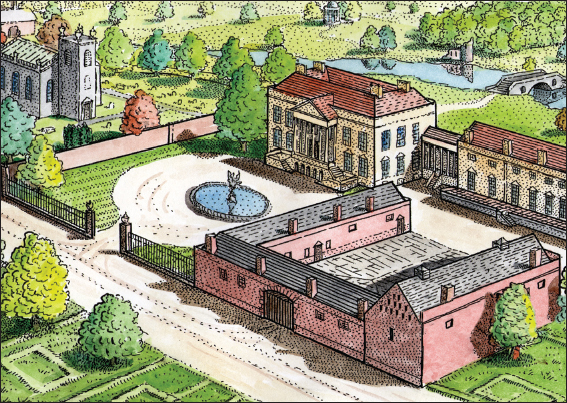
FIG 4.1:
In this view a new country house has been built by the lord of the manor and a landscaped park created around it. The old village which stood here has been removed and all that remains is the parish church and the grassed over footings of the old houses (foreground). This fashion for emparkment was just one of the drastic changes which could affect villages in this period when great estates were created but poverty and discontent blighted the poor
.
H
enry VIII’s formation of the Church of England after his break from Rome caused deeprooted fear and friction between families rich and poor, resulting in the persecution of Catholics. At the other
end of the religious spectrum those who wanted to take reform to extreme lengths included the Puritans who by the 17th century made up a large part of the gentry and, hence, Parliament. Their distrust for King Charles I and his Catholic wife, heightened by his demands for money to finance a war against the Scots, helped to ignite the Civil War in the 1640s. Battles and skirmishes took place all over the country, opposing armies trampled crops, requisitioned livestock, destroyed castles and manor houses, and stacked up casualties. This was a conflict which affected everyone, including the humble villager.
Although the monarchy was restored in 1660, the influence of Parliament and the landowning class had grown. Now their new role in government brought in additional income, which along with exploiting mineral resources on their land, and agricultural improvements on their estates, made them even richer. Rather than spending their money embellishing churches they built themselves great mansions filled with treasures from all over Europe and surrounded by huge landscaped parks. The fate of the village and the villagers in the 17th and 18th centuries was often a story of emparkment and enclosure.
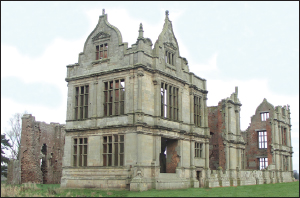
FIG 4.2 MORETON CORBET, SHROPSHIRE:
This small castle (left) had a huge Elizabethan south range (foreground) added in the late 16th century in the latest Classical style. However, during the Civil War this Royalist family had the castle defences destroyed after resisting Parliamentary forces in 1644, with the rest falling into ruin later
.
During this period there were rises in the population which demanded additional food production. This encouraged farmers to put new fields under the plough and to look at ways of increasing their productivity. The 17th and 18th centuries were a time of great innovation in crops, production methods, and breeding of livestock which played their part in changing agriculture from husbandry – the caring for and nurturing of the land – into farming for a profit. Another way of increasing productivity was to increase the amount of land under the plough and during the 17th century there was a resurgence of land reclamation from woods, heaths, moorland, and most famously from the drainage of areas like the Fens. Where this occurred, new hamlets and villages could be founded, especially when the clearance was associated with industry, mining or quarrying. Existing settlements would also be affected with new buildings and farms, the loss of traditional trades
associated with the previous landscape and, in some wetland areas, a diverted river, leaving streets and greens where water once flowed.
It was believed by most innovators that these new agricultural practices would work best within enclosed fields, something which had already been done in many parts of north, west and south-east England by agreement. However, in the central belt of the country from Wiltshire, up through the south and east Midlands and on into Yorkshire, open fields still dominated the landscape and efforts to enclose them met with strong opposition. The pressure to enclose, though, became too great with the sudden upsurge in the population from the mid 18th century, so landlords and enterprising farmers looked to their friends in government to authorise enclosures. Parliamentary enclosures had first occurred in the early 17th century, but between 1750 and 1850 they dramatically increased to change the landscape of the heart of village England.
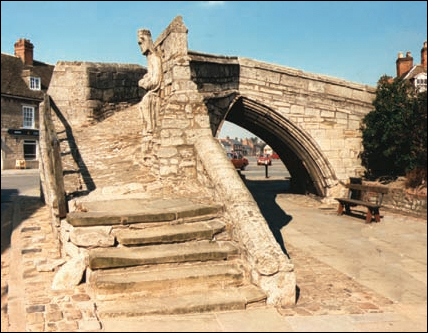
FIG 4.3 CROWLAND, LINCS:
This old three-legged bridge was left high and dry when the rivers which met beneath it were channelled around the village. During the 17th century similar drainage schemes were taking place, the most notable by the Duke of Bedford and his group of Adventure Capitalists who employed the Dutch engineer Vermuyden to build channels in the Fens and make the land suitable for farming. Unfortunately the drying soil, which was very peaty, shrank and the land level dropped below that of the rivers which were meant to be draining it. Windmills powering pumps and new channels were built to solve the problem, but this area is still unnaturally lower than sea level. Names like Bedford Channel and fields called Adventurers Lands record the culprits for posterity
.
The enclosure of a parish would usually be granted as long as those who applied owned the majority of the land, whereupon a commissioner would be appointed. His task was to divide up and allocate the land with some respect to the farmers’ previous holdings. Those with sizable claims would find a new set of fields clustered together rather than sprinkled randomly over the parish, and a new farmhouse at their centre. However, those with very small holdings could lose out altogether and end up as landless labourers. The farmers’ houses left behind in the village were often split up to provide these workers with accommodation, while they relied upon their former neighbours for employment. Their plight had been made worse because the commissioners also enclosed
heaths, meadows, greens and other waste lands which peasants had used to graze their few livestock or where they gathered materials which were essential to their family’s existence. Some villages maintained or even increased their population depending on the success of the new farms; in others the drifting away of landless labourers may have played a part in their continued demise.
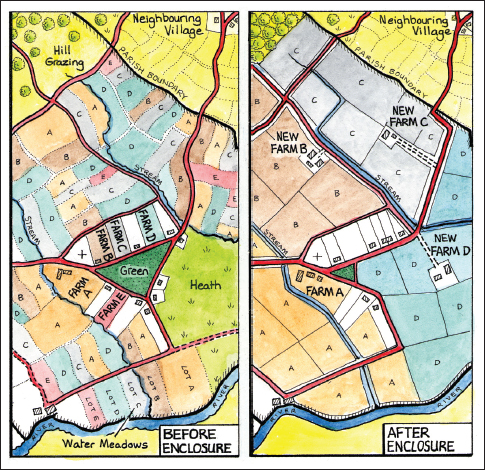
FIG 4.4:
A plan of a village before and after Parliamentary enclosure showing how the dispersed strips of farms A—D were reorganised into their new holdings. Farm E was too small and its lands were absorbed by the others and common land (the hill grazing, heath and green) were also lost. Note the road to the neighbouring village had to be realigned between farms C and D creating a kink which can often still be seen today along parish boundaries
.
The other areas affected by Parliamentary enclosure in the late 18th and early 19th centuries were the
large commons and wastes, especially in the upland regions like the Peak District and the Lake District. These previously open moors and mountains were covered in a grid of dry stone walls with barns erected in the new fields but, unlike the lowlands, the farms themselves often stayed rooted in the village or hamlet. Some of the last royal forests, like Exmoor, were also enclosed at this time as well as many of the heaths of southern England.
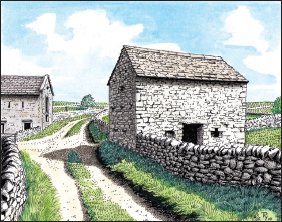
FIG 4.5:
Many of the dry stone walls and barns which are a key feature of upland areas like the Peak District and Lake District were erected during enclosures in this period and may not be as old as their rusticated form implies
.
